PAG XXVI
I was privileged enough this year to be able to attend and present at the Plant and Animal Genome Conference in sunny San Diego, CA, from January 13 - 17. That word 'privilege' is going to be a recurring theme for this post, as I was blown away at how lucky I am to be so supported in my work.
Before I dive into the PAG conference proceedings, I think I should explain what it is I do as a scientist. The goal of my thesis work is to try and better understand the genetic control of traits in pigs that are important to the pig industry; things like the growth of the animal, the composition of the carcass at harvest, and the quality of the meat product that people consume. These traits are really complicated in how they are controlled, involving lots of different genes and proteins interacting with one another.
I look at one little part of this process: microRNAs. If the genome (or entire DNA sequence) is the “book of life”, then ‘genes’ are like paragraphs in that book; they convey a message that is read and then has meaning, or “function” (as proteins). If we follow that analogy, microRNAs are like Tweets; they’re really short, and they aren’t ‘read’ to have function like genes are (i.e. they don’t make proteins). What microRNAs do is ‘fine-tune’ gene expression; they stop a gene from passing its message on to a protein, and they’ve been shown to be involved in a ton of biological processes really important to everyday life. MicroRNAs are present in animals and plants, and are a really exciting area to study for understanding how our bodies work. I use statistics and biology to find areas in the genome controlling the expression of microRNAs, and to see how the microRNAs present in our pigs affect those important growth, carcass, and meat quality traits. If we can find microRNAs that are important to, for example, meat quality in our pigs, we could potentially use that information in breeding programs to select pigs that will make higher-quality meat. I could talk about this forever, so if you have any questions or would like to know more, make sure to reach out to me!
Okay, now back to PAG!
I had previously applied for the Neal A. Jorgenson Genome Travel Award through PAG, which provides funding that greatly offsets the cost of flying across the country and attending a scientific conference. I was selected as a recipient and as such was given the opportunity to present a five-minute ‘pitch’ of my work at the Swine Workshop, to encourage everyone to visit my poster later in the week. It was exciting and nerve-racking to stand up in front of my scientific peers and try to summarize four years of work in five minutes! However, it went really well, and I got great feedback from other researchers in the room. I was glad that the Swine Workshop was so early on in the meeting program, so I got the part I was most nervous about over with quickly. Big thanks go to my lab-mate Ryan for helping keep me calm and listening to me practice in our hotel room the night before!
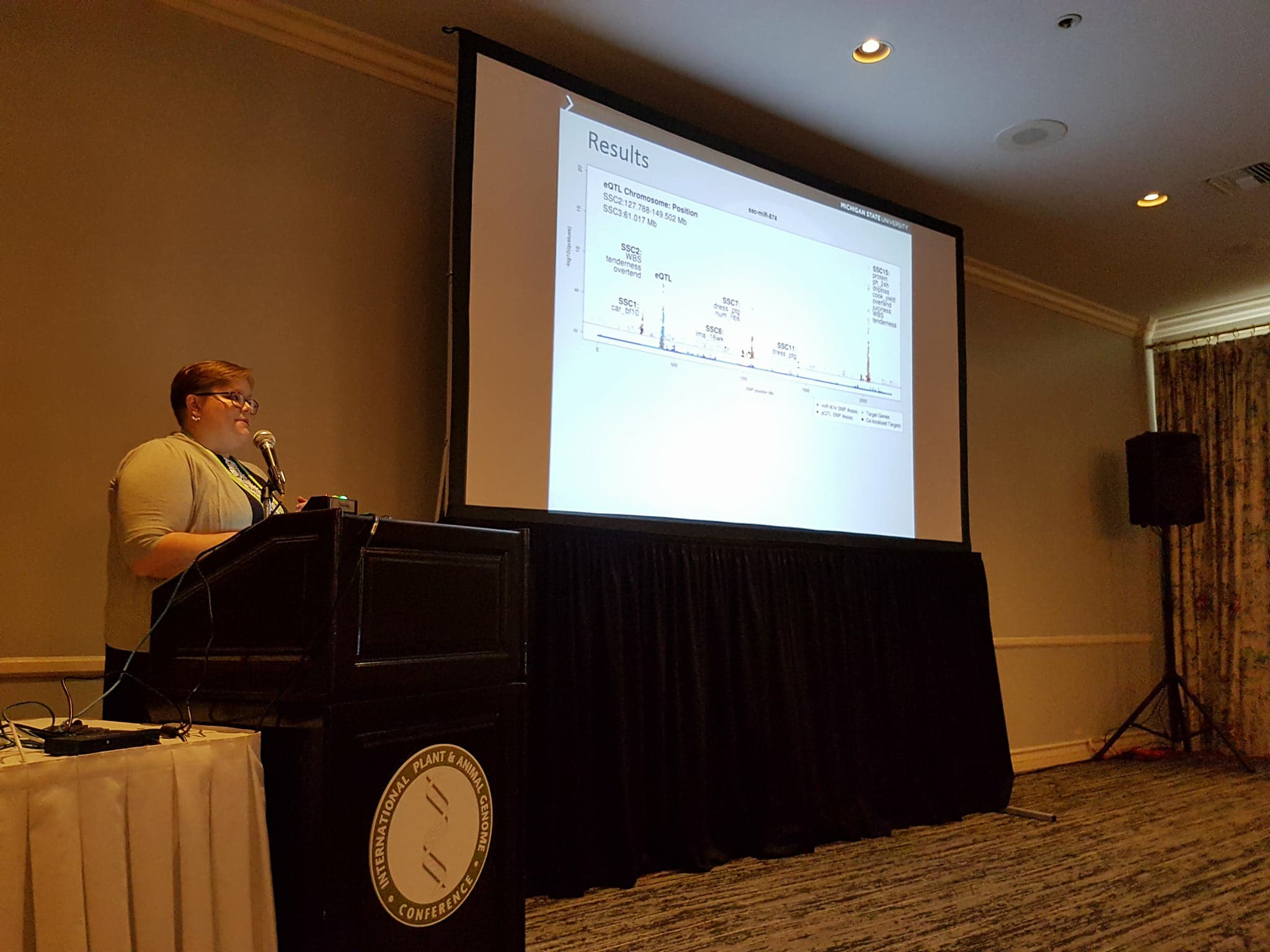
After the Swine Workshop, Ryan and I attended fantastic presentations on a wide range of topics in animal genetics. There were only a few other studies in animals regarding microRNAs, so I branched out a bit and explored some other areas I knew less about. A huge hot topic of this year was epigenetics, which Ryan’s work focuses on in pig development. Epigenetics is a relatively new area of study, and looks at how changes to the actual shape and organization of DNA in a cell can affect the expression of different genes, without changing the actual letter sequence of the DNA strand itself. Dr. Steve Horvath shared his work on using one epigenetic mechanism (DNA methylation marks in the genome) to estimate the age of an individual. It was amazing to see the accuracy he was achieving through this method; in mice, he was looking at only 1,400 spots in the genome (which has about 3 billion bases total) and was able to identify the biological age of the animal with over 90% confidence. He was calling it the “methylation age” of an individual, and discussed how it could be used for not only anti-aging therapies, but understanding why different animals have different life spans. He even mentioned it being useful for veterinarians and animal shelters to know how old an adoptable animal is with more accuracy than dental records – literally ‘looking a gift horse in the mouth’. It was amazing research, and I look forward to hearing more about it as their team learns more.
On Monday, Ryan and I each took our turn presenting our posters. Poster sessions are basically grown-up science fairs, where all the scientists with a poster stand by it to answer questions from anyone interested in their work. They usually last for an hour or two, which can be exhausting and hard on the vocal chords, but I really enjoy them as opposed to more formal oral presentations because I have a chance to connect with colleagues over my science. That’s exactly what happened at PAG; I met some great researchers and exchanged information so we could keep in touch. Ryan also had a great session talking with our collaborators about his most recent results. Meetings like this give us a chance to stand back and see the big picture of the impacts of our work, and be reminded that what we do is something to be excited about. The number of compliments we got from those who stopped by was fantastically reassuring, as well.
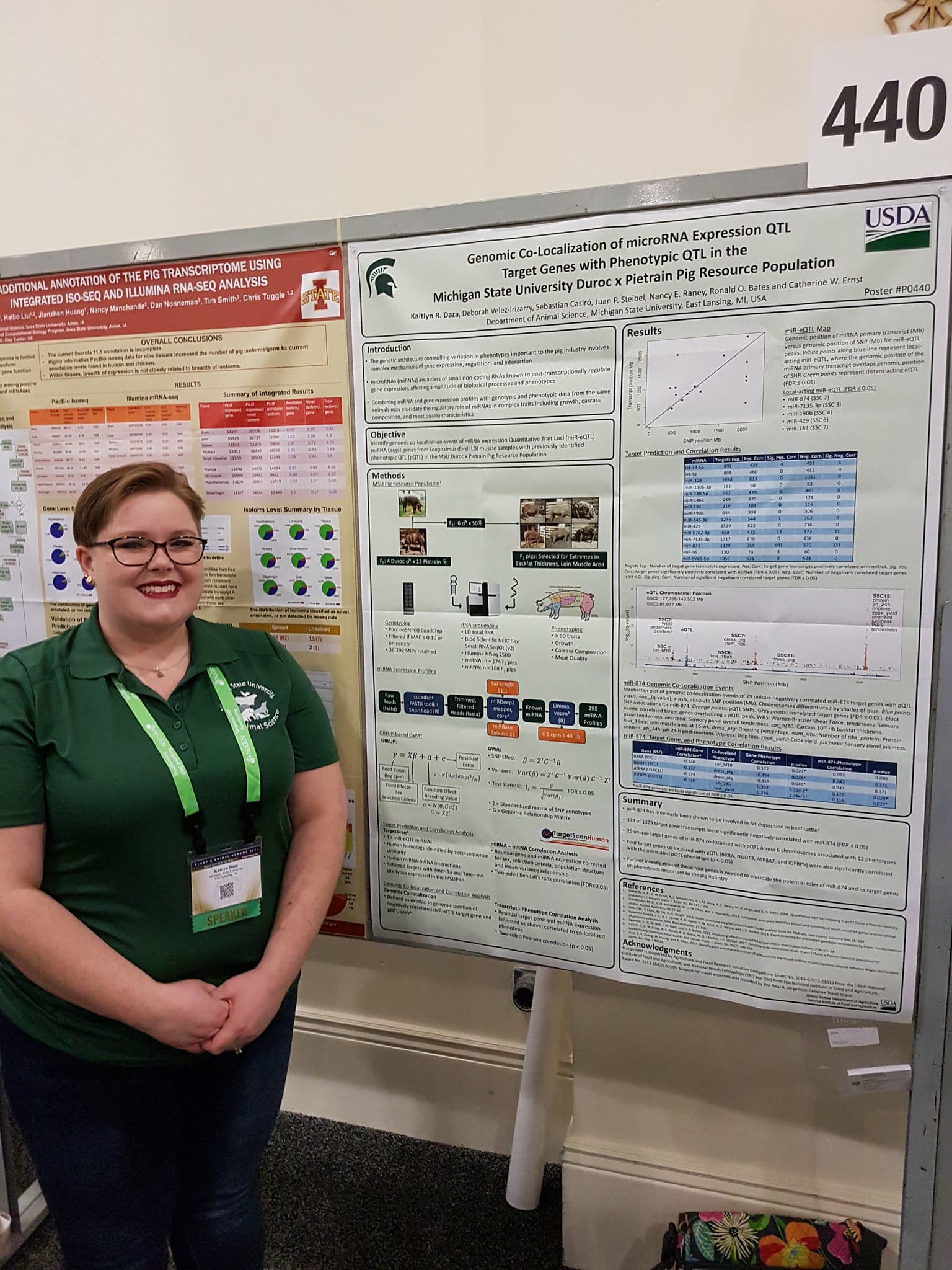
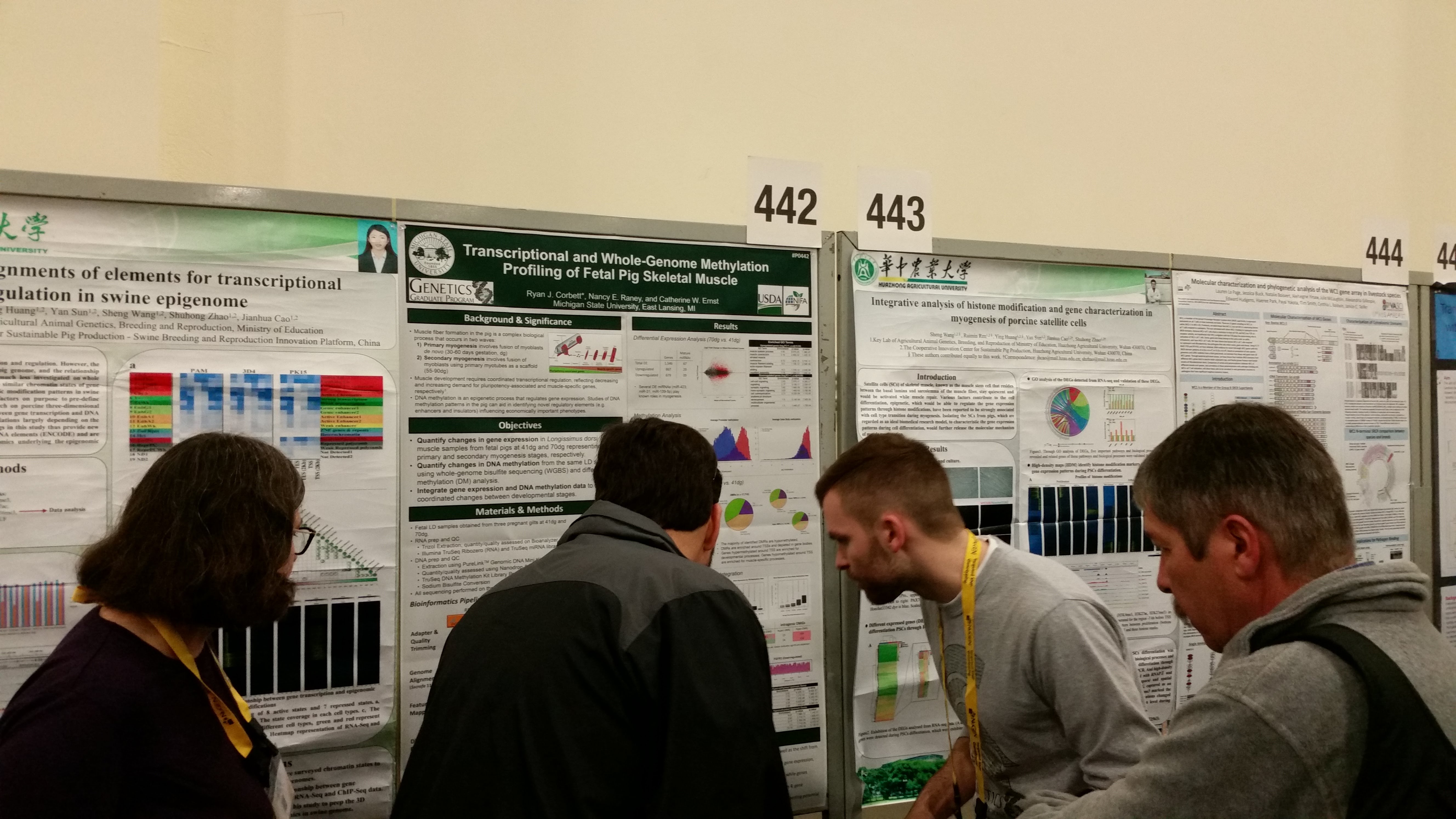
Ryan was also invited to report his recent results surveying DNA methylation during skeletal muscle development in pigs at the Animal Epigenetics session on Tuesday, Jan 16. We realized the day before his talk that he’d be presenting in the ballroom where the giant plenary talks took place, so he got all the fancy digs while he presented. Here’s a picture of him looking like he’s giving a State of the Union address:
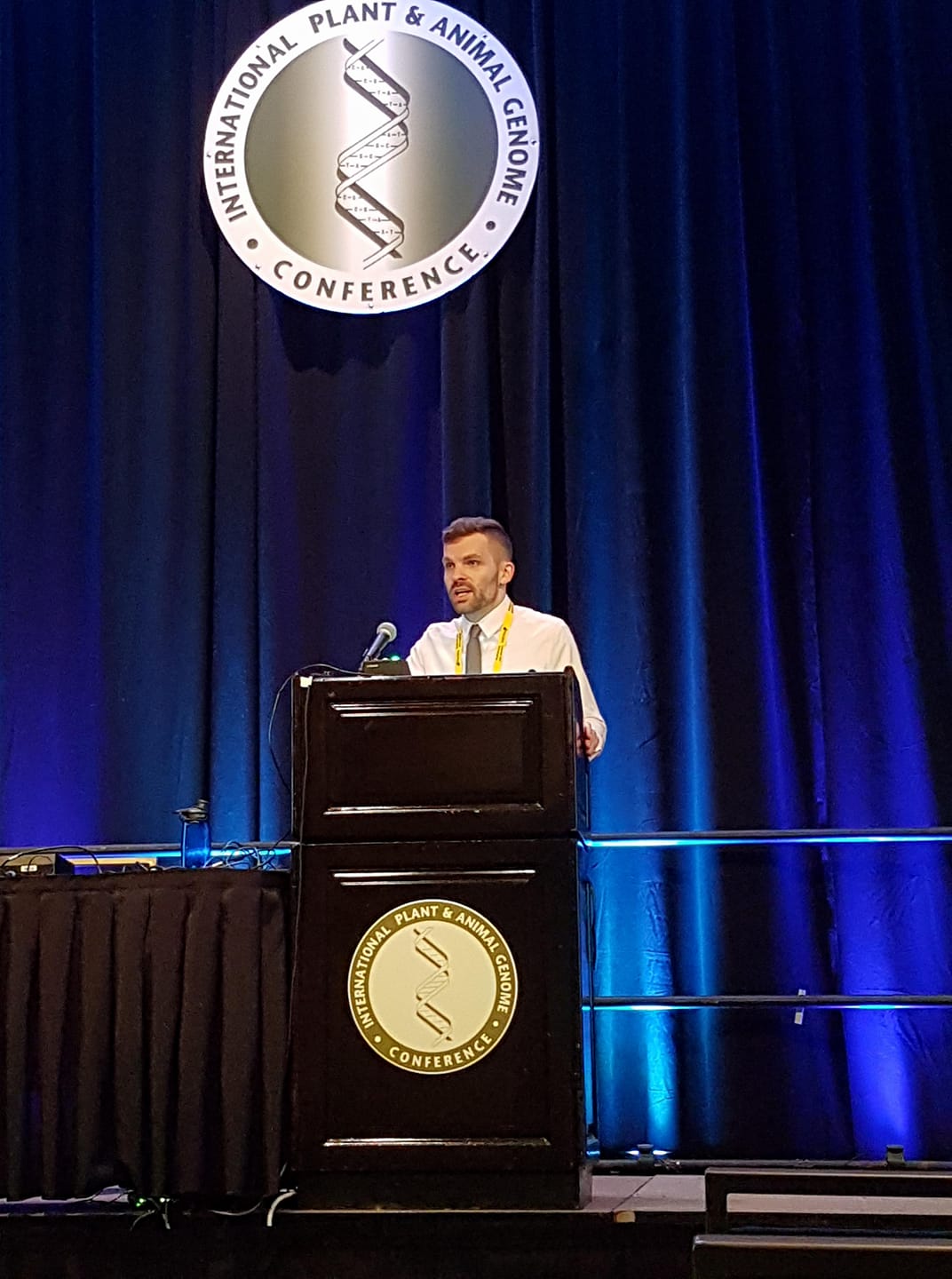
He did amazingly well, and got many handshakes and compliments from our colleagues. It was great to feel like our lab dominated our presentations!
Another session we attended focused on teaching genetics and bioinformatics to non-science majors or younger audiences, which I personally know to be a difficult task. Often with learning genetics comes learning statistics, which intimidates a majority of students. The talks at PAG overviewed different programs designed to introduce non-science majors to DNA extraction, DNA or RNA sequencing, bioinformatics softwares, and data analysis techniques, and shared their successes and lessons learned in the process. I’m personally passionate about introducing students to genetics before their first formal course on the subject, so it was thrilling to see the efforts these educators went through to bring an area I’m so passionate about to others.
Katie Burnette exposing non-science majors to #genetics by extracting bee microbiomes! #PAGXXVI #SoCool #Iwannadothat pic.twitter.com/u3cGIg67DP
— Kaitlyn Daza (@KDaza16) January 14, 2018
It’s hard to pick which talks to describe in this blog post – there were so many that refueled my passion for genetics! One plenary talk given by Dr. Bruce Whitlaw of the Roslin Institute described genome editing and the potential it holds for the livestock industry; there were then conflicting opinions on how successfully it will be integrated into our industry, given the current political and social climate surrounding these technologies. Dr. Sue Lamont from Iowa State University emphasized the importance of poultry to improve food security in the developing world, and how focusing research on adapting birds to the local ecosystems in changing climates (emphasizing complex traits like heat stress and disease resistance) will be crucial to providing sustainable food sources around the globe while empowering women and small communities. I also found another scientist (Dr. Damarius Fleming) researching microRNAs in pigs and had a great discussion about his work identifying microRNAs whose expression changes during PRRSv progression, which could be influential in finding treatments for this horrific disease plaguing our industry. I joked with Ryan that he was my “academic soul-mate”, because it was so refreshing to have someone as knowledgable about the frustrations of working with microRNAs in a non-human species (there are much fewer resources!!). We exchanged contact information, and I’m hoping he’ll get in touch with me about some open-source network analysis software he’s been working with that’s designed for pig data - usually I have to translate everything I do to humans, so this would be so exciting!
Believe it or not, we also had our fair share of fun while traveling. The conference put out a contest called “#PAGHUNT”, where they had hidden stickers with the PAG logo on three plastic lawn flamingos all around the resort. Our task was to find them, and take a fun picture with them to post on Twitter. Ryan and I took this challenge incredibly seriously, and came up with what we thought were hilarious captions for each flamingo we found. We ended up winning the contest, and got some amazing flamingo stuff as a prize! I’ll share the tweets we submitted below. We also went whale watching on a beautiful sunny day, but I didn’t take many pictures as we were edging close to the Mexican border and my phone was freaking out.
Contemplating our next grant: Phenotypic variation in feather color of the family Phoenicopteridae. #PAGXXVI #PAGHUNT pic.twitter.com/1nu4jlo7sn
— Kaitlyn Daza (@KDaza16) January 13, 2018
Look for this, headed to Nature Genetics 2018: Genetic determinants of abnormal feeding behavior in the family Phoenicopteridae. (Sneaky #PAGHUNT putting stickers on backs of flamingos) #PAGXXVI @RI__guy pic.twitter.com/lrNzD71hou
— Kaitlyn Daza (@KDaza16) January 13, 2018
Our final study: Genetic adaptation of the family Phoenicopteridae to captive breeding programs. #FreeTheFlamingo #PAGHUNT #PAGXXVI #3for3 @RI__guy pic.twitter.com/AHh6DcmPld
— Kaitlyn Daza (@KDaza16) January 14, 2018
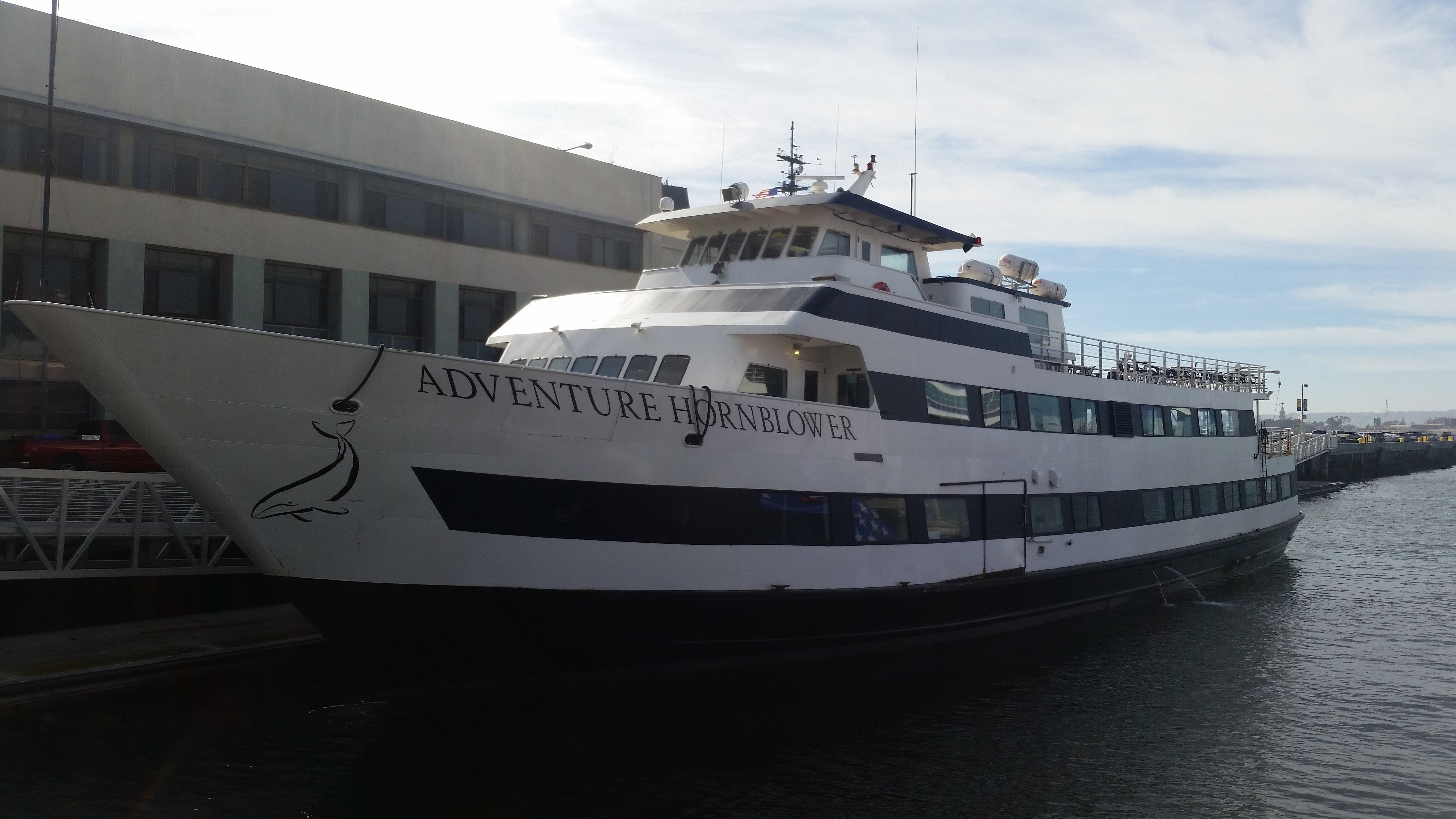

I feel so honored to have been able to share my work at PAG. I met other prominent scientists in my field, and saw familiar faces I’d met at other workshops and conferences. I was proud to see my lab-mate Ryan do so well, this was his first conference with our lab and he impressed everyone with the quality of his work. I joke that I’m the proud soccer-mom of our lab, even though I’m the youngest graduate student in the group. Again, going to meetings like this gives us a chance to see our work from other perspectives. I feel incredibly privileged to have the amazing resources MSU offers at my fingertips, like our sequencing core and high-performance computing center. Smaller institutions and universities usually have to outsource these services, which makes it more difficult for them to control and experience every component of their research process. We are lucky enough to have these amazing facilities on campus so that we can have our hands on each step of every analysis, so I intimately understand what I’m doing and can explain it to others.
Finally, I feel grateful to my advisor. She spent the time to edit our posters, making them look professional and aesthetically pleasing. She (obviously) funds our work and enables us to explore our topics deeply. She has her finger on the pulse of animal genetics research, which means we are asking the pertinent questions of our industry and working at the cutting edge of our field. Finally, she’s incredibly well-connected, meaning we brush elbows with professionals who could potentially keep our careers moving forward. All of this I feel honored to be experiencing, even on the bad days where nothing is working and I feel like giving up. I’m reminded how lucky and blessed I am to be earning this education, and how excited I am for what the future holds.
Coming to meetings like #PAGXXVI remind me how grateful I am for my advisors, for their connectedness in our industry and for having their fingers on the pulse of #AnimalScience research. #blessed #gradschool pic.twitter.com/mUTE8Ystkv
— Kaitlyn Daza (@KDaza16) January 15, 2018
So yeah. I’m a bit of an emotional sap, but going to PAG really brought all these feelings up again. Talk about fuel for the fire! Now to get back to normal and push out these papers. Back to the grinding stone!
Any minute now... https://t.co/HMt50EhKlW pic.twitter.com/mF49vCpShQ
— PHD Comics (@PHDcomics) September 27, 2017